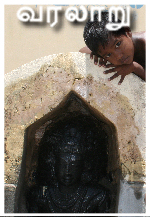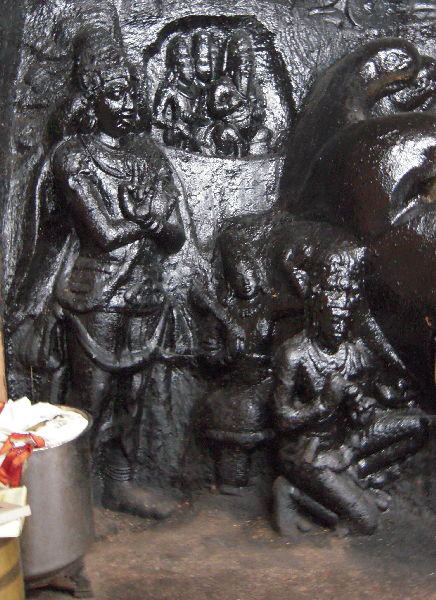 |
 |
 |
http://www.varalaaru.com A Monthly Web Magazine for South Asian History [176 Issues] [1745 Articles] |
 |
 |
 |
http://www.varalaaru.com A Monthly Web Magazine for South Asian History [176 Issues] [1745 Articles] |
|
Issue No. 98

இதழ் 98 [ ஆகஸ்ட் 2013 ] 
இந்த இதழில்.. In this Issue.. 
|
Series:
Pudukkottai Cave Temples
Pallikondaruliya Azhvar Shrine
The sanctum is concaved and is 8.94mts in the east-west direction. The curvature starts at 1.90mts inside from the facade where Vishnu is reclining on Aadhisesha adjoining the back wall11 and the concaved wall is adorned with bas-relief figures portraying the Puranic theme.[12] The reclining Vishnu and Aadhisesha covers the mid portion of the sanctum.[13] The panel can be broadly divided into two; the figures in the upper stratum and the figures in the lower stratum. The figures of lower stratum can be divided into three parts viz., Aadhisesha with reclining Vishnu occupying the mid region, the figures to their west and the figures to their east. The panel in the upper echelon can be divided into three parts the figures on the western wall, eastern wall and the northern wall. In the northern wall Brahma occupies the mid region and it can be further divided as, to the east of Brahma and to the west of Brahma. The Thirumeyyam Pallikondaperumal can be classified as uttama class of depiction.[14] Sculptures in the Lower Stratum  Aadhisesha and the Reclining Vishnu [15] An undulating surface[16] is shown in the middle leaving a portion on western side but extending upto the end of the sanctum wall on the east. The rippled body of Aadhisesha forms an elliptical couch above the undulating surface[17] and its raised head spread like an awning in the west. Among the five heads of Aadhisesha two are carved out as bas-relief in the northern wall and the remaining three are free standing. He looks furious with his eyes and mouth wide open exposing sharp teeth. The sacred literary tradition describes him as white complexioned, thousand headed, finely dotted indicating him a superior breed, king of snakes and capable of spitting fire.[18] Vishnu is reclining on the rug that spread above the couch. The deity is lying straight facing up with his left leg stretched straight but the right leg turned towards Aadhisesha. His left hand stretching to His left is raised upward at the elbow and showing kataka mudra19 whereas the right hand is fully stretched upward and the palm is touching the Adisesha.20 He is richly adorned with stone studded ornaments. He is clad in pattadai which is held by the pearl and stone studded waist belt. Kiritamakuta adorns His head and makarakundalas, flower studs, bangles, armlets, shoulder ornaments, udarabandha, charapali, anklets and rings are the other ornaments adorn by him. The yajnopavita is shown spreading on the couch. Srivatsa mole is shown in the right chest.21 Fire flames are shown on the northern wall of the sanctum above Vishnu.22 It is said that the ferocious Aadhisesha spit fire on the ogres Madhu and Kaithaba.23 Figures to the West of Vishnu There are six figures to the west of Aadhisesha and Vishnu and it starts with Garuda, little above Garuda is seen a niche with three figures seated inside. Adjoining Aadhisesha in the front is Markandeya and behind him is a male figure. Garuda In the lower echelon the panel starts with Garuda24 who is standing in sama with folded wings. He is partially standing on the western and northern wall. His locks are arranged as jatamakuta and few untied locks form a thick pad in the lower head. Patrakundalas, kandigai, charapali, bangles, coiled armlets and head patta are the ornaments worn by him. His lower garment is draping upto his calf which is fastened by a waist belt and its excess girdles tied as a flower knot in the center and dangling in the front. The slackly worn idaikattu has heavy knots flanking on his sides. Hands are kept crossed over his chest, while his left hand is showing darjani, his right hand rests on the chest in kataka. Thick yajnopavita is worn in upavita fashion. He is shown with sharp fangs and spewed out eyes. Figures in the Niche Three figures inside a niche are seen on the northern wall between Aadhisesha and Garuda. The niche is not a proper formation it is simply a hollow in which two seated figures are shown in the front and in between and behind them is the third one, to him only the head is visible. The front two figures are seated in cross legs and among them; the first one is an elderly sage with pot belly, beard and his locks arranged as jatamakuta, beaded mala and bangles adorn him. His hands are near his chest in kataka mudra and his slight grin reveals his excitement at the sight of the deity. The male figure next to the sage looks young with his locks decorated as Karanda makuta and decked with ornaments like kundalas, bangles and kandigai. His right hand is on his right knee and his left hand is in kataka. Both the front figures are wearing lower garment upto their ankle and their vastra yajnopavita is worn in upavita fashion. The third figure is visible only upto his neck and he is adorned with kiritamakuta. Among the three the beard figure looks aged and the other two are young and might be his disciples. Male Figure In between Markandeya and Garuda a male figure is seen behind the Aadhisesha. He is visible upto his waist.25 His left hand is eulogizing the deity whereas his right hand is in kataka holding the stalk of a lotus bud which is resting on his right shoulder. His locks are arranged as jatamakuta and also adorned with ornaments like udarabandha, charapali, coiled armlets, bangles and patrakundalas in elongated ears. Vastra yajnopavita is worn in upavita fashion. He is believed as Yama in the locality.[26] Markandeya Markandeya[27] is seated in garudasana adjoining the Aadhisesha with his hands in kataka near his chest one above the other in which the left hand is holding an object might be flower. His locks are arranged as jatamakuta, ears are elongated without kundalas and his lower garment is draping upto his ankle and his lower wear is fastened by hip belt in which the excess girdle is formed as heavy bow knot and dangle in the front. The vastra yajnopavita worn in upavitha fashion is formed a knot in the left shoulder. Charapali adorns his neck. Footnotes : 11. ibid., R.,uhrntY/ m.fp.nr\hj;jphp/ “,f;Filtiuf; nfhapypd; fUtiwapy; mu';fdpd; gs;spbfhz;l kpfg; bghpa mstpyhdr; rpw;gk; mikf;fg;gl;Lj; J]z;fis Kd;g[wk; kiwj;jthW fhzg;gLfpd;wJ”. But the Pallikondaperumal sculpture is only behind the pillars, and the pillars are in the forefront. P.186 12. ibid., R.,uhrntY/ m.fp.nr\hj;jphp/ “ghk;g[g; gLf;if kPJ Japy; bfhs;Sk; jpUkhypd; bjhg;g[spypUe;J njhd;Wk; fkyj;jpy; ehd;KfDk; kw;Wk; Jk;g[Uehjuh;/ FU/ gpUF Kdpth;/ rf;fuk;/ rptgpuhd;/ R{hpa re;jpuh;fs; Mfpnahh; R{H;e;jpUf;f/ kJ/ iflgh; Mfpa mRuh;fs; fhyoapy; epw;f epykfs; jpUkhypd; ghjj;jpy; mUnf mkh;e;jpUf;f ,r;rpw;gf; fhl;rp ,f;Filtiuiag; bghpJk; mHF bra;fpd;wJ”. P. 186. The authors have given an imprecise list of the Thirumeyyam Vishnu Panel which is tough to identify whom they are naming. Except few like Nanmugan, Nilamagal, Mathu Kaithaba, the rest of the list is not clearly pointed out. Besides, Sivapiran mentioned by them is found nowhere. Guru and Chakkaram are also ambiguous. b#.uh#hKfkJ/ g[Jf;nfhl;il khtl;l tuyhW/ “mde;jrad _h;j;jpf;Fg; gpd;dhy; cs;s Rtw;wpy; xU fijna cUthf;fg;gl;Ls;sJ Rtw;wpy; gy rpw;g';fs; fhQfpd;nwhk;................xU ehlfff; fhl;rpapid capnuhl;lj;Jld; ,';F fy;ypnyna toj;jpUf;f fhz;fpnwhk;. ,Jnghd;w mikg;g[ ntW v';Fk; ,y;iy”. P. 239-240. The same author in his article g[Jf;nfhl;il khtl;l tuyhW/ fUtiwapd; KG gFjpapYk; capnuhl;lkhd rpw;g';fs; gy tof;fg;gl;Ls;sd.................njth;fs;/ fpd;duh;fs;/ ehd;Kfd;/ moath; rpw;g';fs; Mfpad kiyaog;gl;o tp\;Q Filtiuapy; cs;sJ nghy cs;sd”. P.183-184. The author has contradicted his own description for the same place. 13. ibid., R.,uhrntY/ m.fp.nr\hj;jphp/ fUtiwapd; KG ,lj;ija[k; gs;spbfhz;l bgUkhs; gpoj;Js;shh;. P186. The Pallikondaperumal is occupying only the mid region of the sanctum. 14. Rao Gopinatha T.A., Elements of Hindu Iconography, Volume One Part I, Motilal Banarsidass Publishers Pvt. Ltd., Delhi, Reprint-1997. P.90-91. “The depiction of recumbent Vishnu can be classified into uttama (superior), madhyama (middling) and adhama (inferior) forms according to the number of subordinate deities and other beings found in association with the central Vishnu image. The recumbent image of Vishnu with only two hands; about a fourth of the body should be somewhat raised, and the remaining three-fourths should be lying flat upon the serpent bed. The image should be adorned with various ornaments. By the side of the recumbent Vishnu there should be Bhrigu and Markandeya or Markandeya and bhudevi and near the feet the demons Madhu and Kaitabha, while on the lotus issuing from the navel there should be Brahma. On the back wall of the shrine above the level of the image of Vishnu should be sculptured the images of Ayudha-purushas, of Garuda, of Vishvaksena, and of the Sapta-rishis, all standing with their hands in the anjali pose. On the south wall should be shown Brahma and on the north wall Siva, both in the sitting posture. Such a group constitutes Uttama class of Sayanamurti, if figures of Sapta-rishis and Vishvaksena are absent, the group belongs to the Madhyama class; if the Pujakamunis and Madhu and Kaitabha are also absent, it is conceived to belong to the adhama class”. 15. ibid., Soundara Rajan, K.V., mentions the posture as Yoga-samadhi P.103 16. It represents water. Periyzhlwar describe this as “bts;is bts;sj;jpd;nky; xU ghk;ig bkj;ijahf tphpj;J mjd;nkny fs;s epj;jpiu bfhs;fpd;w khh;f;fk;”, “iga mutpd; mizg; ghw;flYs; gs;sp bfhs;fpd;w guk_h;j;jp” Undulating surface is absent in the Malayadipatti recumbent Vishnu depiction. 17. Difference is seen in the spiraling of Adisesha, while Malayadipatti spirals up, Thirumeyyam spirals horizontally. 18. Kulasekara Azhlwar describes him as “,Us;,hpar; Rlh; kzpfs; ,ilf;Fk; bew;wp ,dj;Jj;jp mzp gzk; Mapu';fs; Mh;e;j mut[ murg; bgU"; nrhjp mde;jd; vd;Dk; mzp tps';Fk; cah; bts;is Mizia nktpj;...” (647) “tha; xh; 19. ibid., lhf;lh; b#.uh#hKfkJ/ “bgUkhspd; khh;gpy; j";rk; bfhz;Ls;s jpUkfis ($njtp) mtuJ ,lf;if mizf;f” P.239. The left hand is not in a posture of cuddling or hugging besides it raised above from the elbow and showing kataka. 20. It is said that the right hand is patting and pacifying the ferocious Adhisesha. 21. Periyzhlwar describe this as “ஸtotha; epd; ty khh;gpdpy; thH;fpd;w k';ifa[k;...” 22. ibid., Soundara Rajan, K.V., “multi-pronged arrow like motif shown across the wallஸ” P.103 23. ibid., Soundara Rajan, K.V., “having emitted poisonous fumes against Madhu and Kaithabhaஸ” P.103 24. Kulasekara Azhalwar in his Perumal Thirumozhi describe Garuda as “fhy; Mh;e;j fjpf; fUld; vd;Dk; btd;wpf; fLk;gwit” Fynrfu MH;thh;. 654 25. It is unable to understand the figure below his waist; whether he is depicted only upto his waist or seated above something or seated above his folded legs. But it is obvious something is depicted below him. 26. ibid., lhf;lh;. b#.uh#hKfkJ/ g[Jf;nfhl;il khtl;l tuyhW/ State him as Chitragupt. P.239. 27. ibid., Soundara Rajan, K.V., The author has mentioned both the pujakamunis Markandeya and Bhrgu adorning the frontage of the panel. But the Markandeya-Bhudevi combination is depicted in Thirumeyyam panel. P.103. Such order of depiction is also found at Malayadipatti. this is txt file� |

சிறப்பிதழ்கள் Special Issues 

புகைப்படத் தொகுப்பு Photo Gallery 
|
| (C) 2004, varalaaru.com. All articles are copyrighted to respective authors. Unauthorized reproduction of any article, image or audio/video contents published here, without the prior approval of the authors or varalaaru.com are strictly prohibited. | ||